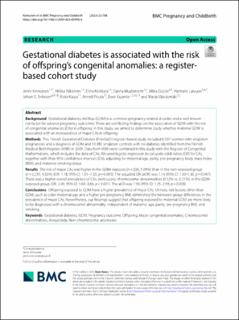| dc.description.abstract | Background
Gestational diabetes mellitus (GDM) is a common pregnancy-related disorder and a well-known risk factor for adverse pregnancy outcomes. There are conflicting findings on the association of GDM with the risk of congenital anomalies (CAs) in offspring. In this study, we aimed to determine study whether maternal GDM is associated with an increased risk of major CAs in offspring.
Methods
This Finnish Gestational Diabetes (FinnGeDi) register-based study included 6,597 women with singleton pregnancies and a diagnosis of GDM and 51,981 singleton controls with no diabetes identified from the Finnish Medical Birth Register (MBR) in 2009. Data from MBR were combined in this study with the Register of Congenital Malformations, which includes the data of CAs. We used logistic regression to calculate odds ratios (OR) for CAs, together with their 95% confidence intervals (CIs), adjusting for maternal age, parity, pre-pregnancy body mass index (BMI), and maternal smoking status.
Results
The risk of major CAs was higher in the GDM-exposed (n = 336, 5.09%) than in the non-exposed group (n = 2,255, 4.33%) (OR: 1.18, 95% CI: 1.05–1.33, p = 0.005). The adjusted OR (aOR) was 1.14 (95% CI: 1.00-1.30, p = 0.047). There was a higher overall prevalence of CAs, particularly chromosomal abnormalities (0.52% vs. 0.21%), in the GDM-exposed group (OR: 2.49, 95% Cl: 1.69–3.66, p < 0.001). The aOR was 1.93 (95% Cl: 1.25–2.99, p = 0.003).
Conclusions
Offspring exposed to GDM have a higher prevalence of major CAs. Of note, risk factors other than GDM, such as older maternal age and a higher pre-pregnancy BMI, diminished the between group differences in the prevalence of major CAs. Nevertheless, our findings suggest that offspring exposed to maternal GDM are more likely to be diagnosed with a chromosomal abnormality, independent of maternal age, parity, pre-pregnancy BMI, and smoking. | en_US |

